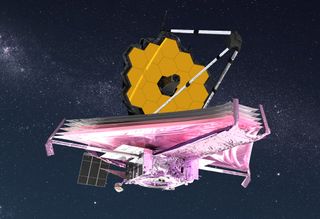The James Webb Space Telescope has solved a lot of puzzles, and created a few more
The new telescope data could be just the beginning, say scientists.

In science, it’s often said that the data doesn’t care what you think. That is especially true when it comes to sophisticated new tools like the James Webb Space Telescope (JWST). So it hasn’t been a shock that some of the data from the JWST isn't quite what scientists expected.
In the 2024 Isaac Asimov Memorial Debate, astrophysicist and science communicator Neil DeGrasse Tyson moderated a discussion at the American Museum of Natural History in New York. The conversation was between scientists and surrounded the topic of how data from the telescope may be shifting our fundamental understanding of our universe. From discrepancies in the age of the universe to the unexpected brightness of early galaxies, the James Webb Space Telescope has already prompted scientists to reconsider how the early universe once operated, leading to revelations that could trigger major shifts in our models of the universe during the next decade or more of the JWST’s tenure.
The data from the telescope "paints a consistent and consistently new picture" of the early universe, said panelist Mike Boylan-Kolchin, a theoretical astrophysicist at the University of Texas at Austin.
Related: The universe might be younger than we think, galaxies' motion suggests
Just because it was impossible to know what the JWST might see, however, doesn't mean scientists didn’t try. Still, it was tough. Arguably the most difficult part, the panelists said, was coming up with basic parameters to base their predictions off of. As Tyson put it, the parameters are like "knobs you turn" in computer simulations of the universe meant to project outcomes based on hypotheses. To pose an example, panelist Rachel Somerville, a senior research scientist at Flatiron Institute’s Center for Computational Astrophysics in New York City, described a study she had worked on that tried to predict what JWST would see.
"We turned all the knobs in our models to match the nearby universe," said Somerville. But something wasn't right. "We disagreed with the observations," she said. After looking over the data, Somerville and her team discovered that their predictions would be more accurate if they took into account the increased density of the early universe, which was smaller than our currently more expanded universe, yet contained the same amount of mass.
Other problems were not so easily resolved. For instance, many observations made by the JWST revealed that the early universe was a surprisingly vibrant place, with galaxies far larger and brighter than scientists predicted.
Get the Space.com Newsletter
Breaking space news, the latest updates on rocket launches, skywatching events and more!
"I don't think anybody's models really predicted how much activity there was then," said Boylan-Kolchin. It seems like "everything is happening faster than we thought in the early universe."
The case of the surprisingly active early universe might be related to another well-known discrepancy in astrophysics — the age of the universe.
The Hubble Space Telescope was a huge factor in helping narrow down the scientific consensus on the universe's age — in fact, the telescope's mirrors were specifically made to observe stars called Cepheids that astronomers can use to calculate that age, said panelist Wendy Freedman, a cosmologist at the University of Chicago. The resulting measurement of the universe’s age, about 13.7 billion years, has stood ever since.
But, let's not forget there is another way to measure the age of the universe, said Boylan-Kolchin.
"That's with the cosmic microwave background, the light from the earliest phases of the universe,” he said. Using this method, scientists came up with a slightly larger number — 13.8 billion years. And while that difference may not seem huge, some estimates using Cepheids are as low as 12.8 billion years, said Boylan-Kolchin. Worse, no one knows where the difference comes from. "It's like, we're digging a tunnel on opposite sides of a mountain, and we missed," said Freedman.
Unfortunately, the surprisingly luminous early galaxies the JWST discovered did nothing to solve this mystery.
In fact, the telescope's results led Rajendra Gupta, an astrophysicist at the University of Ottawa, to publish a paper suggesting that, based on the new data, the universe could be as ancient as 26.8 billion years old, about twice as old as current estimates. While the panelists agreed that Gupta's suggestion is extremely unlikely, the discrepancy of the universe's age in general does suggest the standard cosmological model and our understanding of the impact dark matter and dark energy have on our universe, may need some revamping.
It could be that "something fundamental is missing in our current picture," said Freedman.
On the bright side, it looks like data from JWST can do more than just point out discrepancies — it may be able to help scientists answer some fundamental questions in astronomy that have persisted for decades. The telescope also won’t be the only technology helping solve these problems. New tools like artificial intelligence and increasingly powerful supercomputers might help; other telescopes, like the Giant Magellan Telescope, a huge optical telescope under construction in Chile that Freedman has led the development of, will add to the high-quality data at scientists' disposal, too. With so many new tools, the amount and quality of data will be unprecedented, said panelist Priya Natarajan, a theoretical astrophysicist at Yale University.
"We are in the midst of a revolution in terms of data," she said. "Soon it's going to start really tightly constraining the models and hence our theoretical understanding."
Join our Space Forums to keep talking space on the latest missions, night sky and more! And if you have a news tip, correction or comment, let us know at: community@space.com.

Rebecca Sohn is a freelance science writer. She writes about a variety of science, health and environmental topics, and is particularly interested in how science impacts people's lives. She has been an intern at CalMatters and STAT, as well as a science fellow at Mashable. Rebecca, a native of the Boston area, studied English literature and minored in music at Skidmore College in Upstate New York and later studied science journalism at New York University.
-
Torbjorn Larsson Notably Webb has confirmed the LCDM cosmology, it is our understanding of star, galaxy and black hole evolution that may be in need of revisions. Since the article was written DESI has put out its cosmological results, and it too agrees with the age of the universe (agrees with CMB Hubble constant). It is when it overlaps with supernova surveys and adds those that there is significant disagreement. But the earlier eROSITA gamma sky survey used DESI quasars as well and made a model evaluation: the data supports LCDM, not new physics.Reply -
Unclear Engineer Well, I do not agree that Webb has confirmed the Lambda part of the theory. In the current theory, lambda is a constant, and the "Hubble tension" seems to indicate that it should be some sort of variable with time.Reply
From GRT, I would not even be surprised if the rate of time passage is related to the mass density of the universe. But, we would have a very hard time figuring that out.
